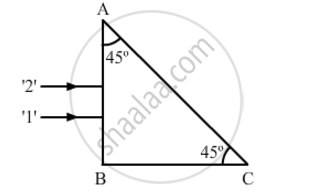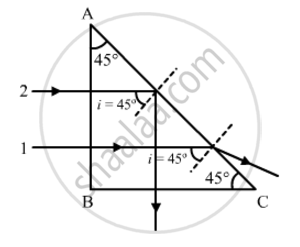Advertisements
Advertisements
Question
Two monochromatic rays of light are incident normally on the face AB of an isosceles right-angled prism ABC. The refractive indices of the glass prism for the two rays '1' and '2' are respectively 1.3 and 1.5. Trace the path of these rays after entering the prism.

Solution
Critical angle of ray 1:
`sin(c_1)=1/mu_1=1/1.3`
`=>c_1=sin^(-1)(1/1.3)=50.35^@`
Similarly, critical angle of ray 2:
`sin(c_2)=1/mu_0=1/1.52`
`=>c_2=sin^(-1)(1/1.52)=41.14^@`
Both the rays will fall on the side AC with angle of incidence (i) equal to 45°. Critical angle of ray 1 is greater than that of i. Hence, it will emerge from the prism as shown in the figure. Critical angle of ray 2 is less than that of i. Hence, it will be internally reflected as shown in the figure

APPEARS IN
RELATED QUESTIONS
Monochromatic light of frequency 6.0 × 1014 Hz is produced by a laser. The power emitted is 2.0 × 10−3 W. Estimate the number of photons emitted per second on an average by the source
'Two independent monochromatic sources of light cannot produce a sustained interference pattern'. Give reason.
A monochromatic ray of light falls on a regular prism. What is the relation between the angle of incidence and angle of emergence in the case of minimum deviation?
State the essential conditions for diffraction of light ?
When monochromatic light travels from a rarer to a denser medium, explain the following, giving reasons:
(i) Is the frequency of reflected and refracted light same as the frequency of incident light?
(ii) Does the decrease in speed imply a reduction in the energy carried by light wave?
State Huygen’s principle. Using this principle explain how a diffraction pattern is obtained on a screen due to a narrow slit on which a narrow beam coming from a `=> n = (vlamda)/(vlamda_omega)`monochromatic source of light is incident normally.
Which of the following sources provides the best monochromatic light?
Can the interference pattern be produced by two independent monochromatic sources of light? Explain.
A narrow slit is illuminated by a parallel beam of monochromatic light of wavelength λ equal to 6000 Å and the angular width of the central maximum in the resulting diffraction pattern is measured. When the slit is next illuminated by light of wavelength λ’, the angular width decreases by 30%. Calculate the value of the wavelength λ’.
The Figure below shows a ray of monochromatic light LM incident on the first surface AB of a regular (equilateral) glass prism ABC. The emergent ray grazes the adjacent surface AC. Calculate the angle of incidence. (Refractive Index of glass = 1.5)

